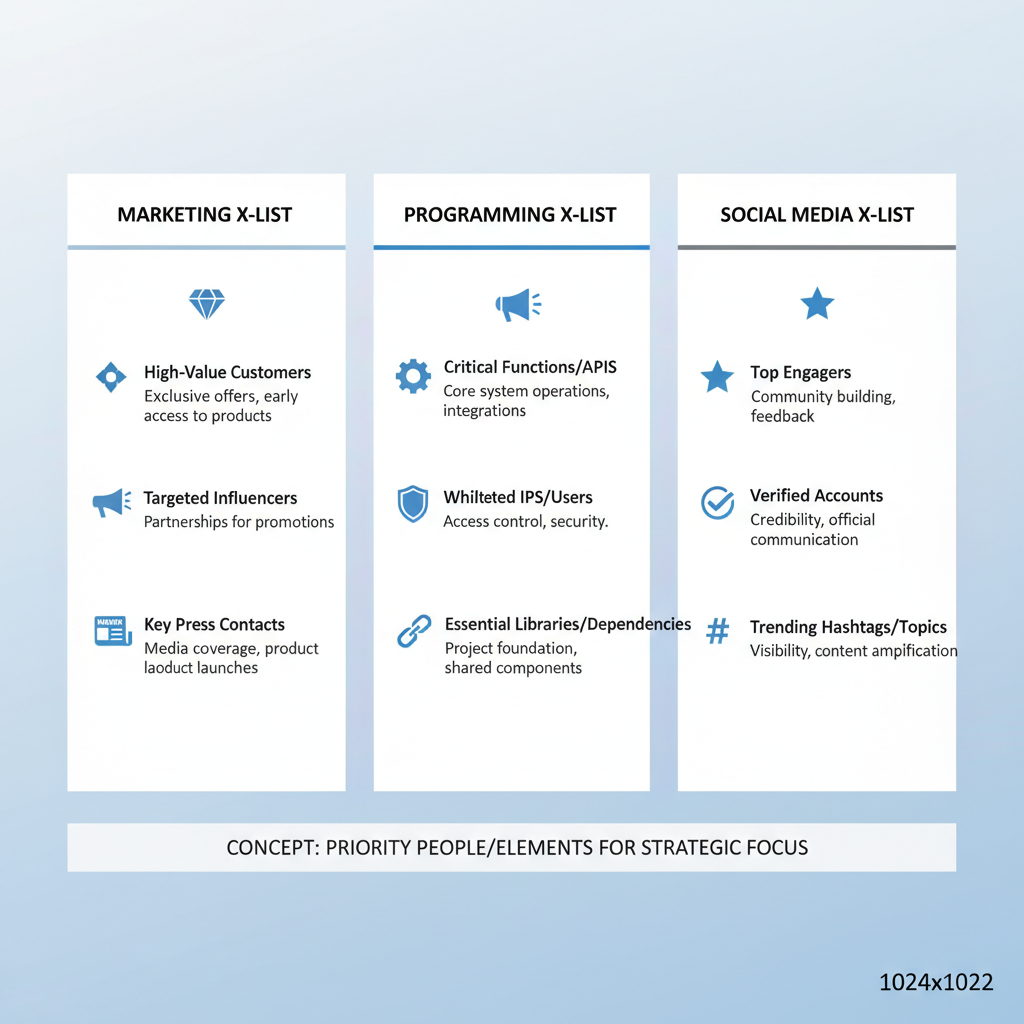An X List Explained and Steps to Create One
Learn what an X list is, its uses in marketing, programming, and social media, and follow a clear step-by-step process to create one effectively.

Introduction to "An X List"
In today's fast-paced, information-rich environment, having a clear and actionable method for organizing priorities is essential. One powerful concept is the "X list"—a curated set of items where the “X” stands for any defining characteristic relevant to your goal, whether in marketing, programming, or social media. Understanding what an X list is and how to apply it can help you sharpen focus, improve workflows, and boost productivity.

Understanding What "An X List" Is
The phrase "an X list" is a flexible term used across different domains. It typically refers to a curated set of items, tasks, names, or priorities signified by the variable “X”—which could be anything from goals to forbidden elements. Depending on the context, the meaning of X changes, but the underlying concept remains: it’s a list with a purpose.
In Marketing
An X list in marketing might refer to a VIP customer list, email subscriber segment, or priority contact roster. Here, “X” denotes the defining characteristic or filter applied—such as “top buyers,” “press contacts,” or “high-value leads.”
In Programming
In development, “X list” often means a collection tied to a specific type, such as a list of variables of type X in code, or an exclusion list (“blacklist”, “block list”). It can also be a literal data structure named `xList` in code for holding objects of a particular class.
In Social Media
Social media managers use the term to describe curated groups—like Twitter Lists (e.g., “Influencer X List”) or Instagram close-friends lists. The “X” often defines the theme or purpose—such as “design inspiration,” “collaboration prospects,” or “content tracking.”
---
Origins and Evolution of the Term
While the exact origin is difficult to pinpoint, the concept stems from the use of “X” as a placeholder for a variable or unknown in algebra. Over time, tech circles adopted “X” to symbolize a customizable or context-driven category, expanding into marketing and content management vocabulary.
The phrase gained traction with:
- Email marketing segmentation (early 2000s)
- Data type declarations in code
- Social platform list features
Its cross-disciplinary usage solidified “X list” as shorthand for a tailored collection.
---
Why an X List is Useful
An X list’s versatility lies in its ability to organize information based on a defining characteristic. Whether you’re tracking features for a product release, maintaining a list of high-priority leads, or curating hashtags for campaigns, an X list:
- Provides quick access to relevant items
- Reduces cognitive load
- Improves focus on what matters most

---
Key Elements of an Effective X List
To ensure your X list serves its purpose:
- Clear Criteria: Define what “X” means.
- Consistent Format: Keep items structured for easy scanning.
- Prioritization: Arrange based on importance or urgency.
- Accessibility: Ensure the list is easy to update and share.
- Context Notes: Sometimes items need annotations to clarify why they belong.
---
Step-by-Step Guide to Creating an X List
Crafting a useful X list follows a systematic process. Let’s break it down with examples from marketing, programming, and social media.
Step 1: Define “X”
Ask: “What does X represent here?” Examples:
- Marketing: “Top 20 Leads to Contact This Month”
- Programming: “UserIDs with Admin Access”
- Social Media: “Instagram accounts for design inspiration”
Step 2: Select a Format
Choose between:
- Digital (spreadsheets, apps)
- Physical (sticky notes, bullet journal)
Step 3: Gather Items
Collect data via CRM, analytics tools, code database, or manual research.
Step 4: Organize & Annotate
Include relevant info. Example in code:
xList = ["user001", "user102", "user305"] # Admin usersIn marketing, annotate why the lead is top priority:
- “Opened last 3 campaigns”
- “High purchase history”
Step 5: Maintain & Review
Set a periodic review schedule.
---
| Field | Example X | List Items | Purpose |
|---|---|---|---|
| Marketing | High-Value Leads | Lead1, Lead2, Lead3 | Drive conversions |
| Programming | Blocked IPs | 192.168.1.50, 10.0.0.27 | Prevent security threats |
| Social Media | Brand Advocates | @userA, @userB, @userC | Amplify reach |
---
Best Practices for Maintaining and Updating an X List
- Automate Updates: Use integrations to pull fresh data.
- Version Control: Keep historical records for context.
- Validate Entries: Remove outdated or irrelevant items.
- Cross-Reference: Link lists if they share dependencies.
---
Common Mistakes and Pitfalls
Avoid:
- Undefined “X”: Without clear criteria, relevance suffers.
- Overloading: Too many items reduce focus.
- Ignoring Updates: Stale lists lose utility.
- Poor Accessibility: If others can’t access it, collaboration fails.
---
Tools and Formats for Building X Lists
Digital Tools
- Trello / Asana: Visual boards for project-related X lists.
- Google Sheets: Flexible for collaborative data-driven lists.
- Notion: Supports tags, relations, and rich context.
Physical Formats
- Bullet Journals: Ideal for personal productivity lists.
- Whiteboards: Great for team brainstorming sessions.

---
How an X List Improves Productivity and Clarity
With an X list, you can:
- Focus on priorities rather than the entire dataset.
- Communicate clearly what’s in scope.
- Measure progress more effectively.
- Reduce redundancy in workflows.
Example: In agile development, a sprint’s “bug fix X list” keeps the team aligned on the issues that must be resolved before release.
---
Future Trends in Using X Lists
Looking ahead:
- AI-Assisted Lists: Automatically generating X lists based on real-time analytics.
- Cross-Platform Syncing: Unified lists accessible across devices.
- Enhanced Visualization: Graphs and charts to represent list data.
- Voice-Based Management: Create and edit X lists via smart assistants.
---
Summary and Call to Action
An X list is a dynamic, customizable framework adaptable to marketing, programming, social media, and beyond. Defining “X” clearly, choosing the right format, and maintaining your list with discipline can lead to greater focus, better communication, and improved productivity. Start creating your own X list today—identify your “X” and watch how it transforms your workflow.




